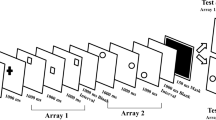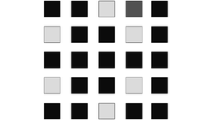Abstract
Previous studies have shown that, under specific conditions, arrays that have been pointed at encoding are recognized better than passively viewed ones. According to one interpretation, the superior recognition of pointed-to arrays can be explained by the motor inhibition of passively viewed arrays. The present study sought to determine whether a similar motor inhibition can be induced also when the participants observed a co-actor perform the pointing movements. Participants were presented with two spatial arrays, one of which was encoded via observation only (the no-move array), while the other was encoded with pointing movements (the move array); movements were performed either by the participant or by the experimenter. Experiment 1 replicated the advantage of self-pointed arrays over passively viewed arrays. Experiment 2 showed that, when participants passively observed the pointing movements performed by the experimenter, move arrays were recognized no better than no-move arrays. Finally, Experiment 3 demonstrated that, in a joint-action condition in which participants alternated with the experimenter in making pointing movements, the advantage of experimenter-pointed arrays over passively viewed arrays was significant and similar in size to the advantage produced by self-performed movements. Importantly, a series of cross-experiment comparisons indicated that the higher recognition of both self- and experimenter-pointed arrays in Experiment 3 could be explained by the motor inhibition of no-move arrays. We propose that, in a joint condition, the pointing movements performed by the experimenter were represented in the same functional way as self-performed movements and that this produced the motor inhibition of passively viewed arrays.





Similar content being viewed by others
Notes
In line with the previous studies, we will use the terms ‘pointing movements’ to refer to actions performed by participants on one of the two arrays presented in each trial. However, it is worth noting that the actions described by Chum et al. (2007) and Dodd and Shumborski (2009) were actually tapping movements, as participants were instructed to touch the location of the presented items on the screen—“Moreover, participants were instructed that they would be passively viewing the location of each object for one of the arrays (no-move array) and tapping each object as it appeared on the screen in the other array (move array)” (Dodd & Shumborski, 2009, p. 1239). In the present study, we followed the same procedure, although we acknowledge that there may be important differences between pointing and tapping gestures. In fact, only pointing gestures represent social-communicative acts that signal the protagonist's intention to direct the perceiver's attention to the pointed information (Gliga & Csibra, 2009; Yoon, Johnson, & Csibra, 2008). To our knowledge, the question of whether these two types of gestures have different effects on spatial memory has not been investigated and represents an interesting avenue for future research.
References
Anderson, M. C., Bjork, E. L., & Bjork, R. A. (2000). Retrieval-induced forgetting: Evidence for a recall-specific mechanism. Psychonomic Bulletin and Review, 7, 522–530.
Atmaca, S., Sebanz, N., & Knoblich, G. (2011). The joint flanker effect: Sharing tasks with real and imagined co-actors. Experimental Brain Research, 211(3–4), 371–385. https://doi.org/10.1007/s00221-011-2709-9.
Baddeley, A. D., & Hitch, G. (1974). Working memory. Psychology of Learning and Motivation, 8, 47–89. https://doi.org/10.1016/S0079-7421(08)60452-1.
Brass, M., Bekkering, H., & Prinz, W. (2001). Movement observation affects movement execution in a simple response task. Acta Psychologica, 106(1–2), 3–22. https://doi.org/10.1016/S0001-6918(00)00024-X.
Burgess, N. (2006). Spatial memory: How egocentric and allocentric combine. Trends in Cognitive Sciences, 10(12), 551–557. https://doi.org/10.1016/j.tics.2006.10.005.
Chum, M., Bekkering, H., Dodd, M. D., & Pratt, J. (2007). Motor and visual codes interact to facilitate visuospatial memory performance. Psychonomic Bulletin and Review, 14(6), 1189–1193. https://doi.org/10.3758/BF03193111.
Constable, M. D., Pratt, J., & Welsh, T. N. (2018). “Two Minds Don’t Blink Alike”: The Attentional blink does not occur in a joint context. Frontiers in Psychology, 9, 1714. https://doi.org/10.3389/fpsyg.2018.01714.
Decety, J., & Grèzes, J. (2006). The power of simulation: Imagining one’s own and other’s behavior. Brain Research, 1079(1), 4–14. https://doi.org/10.1016/j.brainres.2005.12.115.
Denis, M., Engelkamp, J., & Mohr, G. (1991). Memory of imagined actions: Imagining oneself or another person. Psychological Research, 53(3), 246–250. https://doi.org/10.1007/BF00941394.
Dodd, M. D., & Shumborski, S. (2009). Examining the influence of action on spatial working memory: The importance of selection. The Quarterly Journal of Experimental Psychology, 62(6), 1236–1247. https://doi.org/10.1080/17470210802439869.
Dolk, T., Hommel, B., Prinz, W., & Liepelt, R. (2013). The (not so) social Simon effect: A referential coding account. Journal of Experimental Psychology: Human Perception and Performance, 39(5), 1248. https://doi.org/10.1037/a0031031.
Engelkamp, J., & Zimmer, H. D. (1989). Memory for action events: A new field of research. Psychological Research, 51(4), 153–157. https://doi.org/10.1007/BF00309142.
Engelkamp, J., & Zimmer, H. D. (1997). Sensory factors in memory for subject-performed tasks. Acta Psychologica, 96(1–2), 43–60. https://doi.org/10.1016/S0001-6918(97)00005-X.
Enticott, P. G., Johnston, P. J., Herring, S. E., Hoy, K. E., & Fitzgerald, P. B. (2008). Mirror neuron activation is associated with facial emotion processing. Neuropsychologia, 46(11), 2851–2854. https://doi.org/10.1016/j.neuropsychologia.2008.04.022.
Eskenazi, T., Doerrfeld, A., Logan, G. D., Knoblich, G., & Sebanz, N. (2013). Your words are my words: Effects of acting together on encoding. The Quarterly Journal of Experimental Psychology, 66(5), 1026–1034. https://doi.org/10.1080/17470218.2012.725058.
Faul, F., Erdfelder, E., Lang, A., & Buchner, A. (2007). GPower 3: A flexible statistical power analysis program for the social, behavioral, and biomedical sciences. Behavior Research Methods, 39(2), 175–191. https://doi.org/10.3758/BF03193146.
Fischer, M. H., & Hoellen, N. (2004). Space- and object-based attention depend on motor intention. Journal of General Psychology, 131(4), 365–377.
Galantucci, B., & Sebanz, N. (2009). Joint action: Current perspectives. Topics in Cognitive Science, 1(2), 255–259. https://doi.org/10.1111/j.1756-8765.2009.01017.x.
Gliga, T., & Csibra, G. (2009). One-year-old infants appreciate the referential nature of deictic gestures and words. Psychological Science, 20(3), 347–353.
Goodale, M. A., & Milner, A. D. (1992). Separate visual pathways for perception and action. Trends in Neurosciences, 15(1), 20–25.
Grèzes, J., & Decety, J. (2001). Functional anatomy of execution, mental simulation, observation, and verb generation of actions: A meta-analysis. Human Brain Mapping, 12(1), 1–19. https://doi.org/10.1002/1097-0193(200101)12:1%3c1:AID-HBM10%3e3.0.CO;2-V.
Hogeveen, J., & Obhi, S. S. (2012). Social interaction enhances motor resonance for observed human actions. Journal of Neuroscience, 32(17), 5984–5989.
Holländer, A., Jung, C., & Prinz, W. (2011). Covert motor activity on NoGo trials in a task sharing paradigm: Evidence from the lateralized readiness potential. Experimental Brain Research, 211(3–4), 345–356.
Humphreys, G. W., & Sui, J. (2016). Attentional control and the self: The Self-Attention Network (SAN). Cognitive Neuroscience, 7(1–4), 5–17. https://doi.org/10.1080/17588928.2015.1044427.
Iacoboni, M., Molnar-Szakacs, I., Gallese, V., Buccino, G., Mazziotta, J. C., & Rizzolatti, G. (2005). Grasping the intentions of others with one’s own mirror neuron system. PLoS Biology, 3(3), e79. https://doi.org/10.1371/journal.pbio.0030079.
Jeannerod, M. (2001). Neural simulation of action: A unifying mechanism for motor cognition. Neuroimage, 14(1), S103–S109. https://doi.org/10.1006/nimg.2001.0832.
Kourtis, D., Sebanz, N., & Knoblich, G. (2010). Favouritism in the motor system: Social interaction modulates action simulation. Biology Letters, 6(6), 758–761. https://doi.org/10.1098/rsbl.2010.0478.
Kourtis, D., Sebanz, N., & Knoblich, G. (2013). Predictive representation of other people’s actions in joint action planning: An EEG study. Social Neuroscience, 8(1), 31–42.
Lange, N., Hollins, T. J., & Bach, P. (2017). Testing the motor simulation account of source errors for actions in recall. Frontiers in Psychology, 8, 1686. https://doi.org/10.3389/fpsyg.2017.01686.
Leynes, P. A., & Kakadia, B. (2013). Variations in retrieval monitoring during action memory judgments: Evidence from event-related potentials (ERPs). International Journal of Psychophysiology, 87(2), 189–199. https://doi.org/10.1016/j.ijpsycho.2013.01.004.
Lindner, I., Echterhoff, G., Davidson, P. R., & Brand, M. (2010). Observation inflation: Your actions become mine. Psychological Science, 21(9), 1291–1299. https://doi.org/10.1177/0956797610379860.
Lindner, I., Schain, C., & Echterhoff, G. (2016). Other-self confusions in action memory: The role of motor processes. Cognition, 149, 67–76. https://doi.org/10.1016/j.cognition.2016.01.003.
Logie, R. H. (1995). Visuo-spatial working memory. Hillsdale, NJ, US: Lawrence Erlbaum Associates Inc.
Quinn, J. G. (2008). Movement and visual coding: The structure of visuo-spatial working memory. Cognitive Processing, 9(1), 35–43. https://doi.org/10.1007/s10339-007-0184-9.
Ramnani, N., & Miall, R. C. (2004). A system in the human brain for predicting the actions of others. Nature Neuroscience, 7(1), 85–90. https://doi.org/10.1038/nn1168.
Rizzolatti, G., & Craighero, L. (2004). The mirror-neuron system. Annual Review of Neuroscience, 27, 169–192. https://doi.org/10.1146/annurev.neuro.27.070203.144230.
Rizzolatti, G., Fadiga, L., Gallese, V., & Fogassi, L. (1996). Premotor cortex and the recognition of motor actions. Cognitive Brain Research, 3(2), 131–141.
Rizzolatti, G., & Matelli, M. (2003). Two different streams form the dorsal visual system: Anatomy and functions. Experimental Brain Research, 153(2), 146–157.
Rossi-Arnaud, C., Pieroni, L., Spataro, P., & Baddeley, A. (2012). Working memory and individual differences in the encoding of vertical, horizontal and diagonal symmetry. Acta Psychologica, 141(1), 122–132. https://doi.org/10.1016/j.actpsy.2012.06.007.
Rossi-Arnaud, C., Spataro, P., & Longobardi, E. (2012). Effects of pointing on the recall of simultaneous and sequential visuospatial arrays: A role for retrieval strategies? Psychological Research, 76(6), 699–712. https://doi.org/10.1007/s00426-011-0394-8.
Sapkota, R. P., Pardhan, S., & van der Linde, I. (2013). Manual tapping enhances visual short-term memory performance where visual and motor coordinates correspond. British Journal of Psychology, 104(2), 249–264. https://doi.org/10.1111/j.2044-8295.2012.02115.x.
Save, E., & Moghaddam, M. (1996). Effects of lesions of the associative parietal cortex on the acquisition and use of spatial memory in egocentric and allocentric navigation tasks in the rat. Behavioral Neuroscience, 110(1), 74–85. https://doi.org/10.1037/0735-7044.110.1.74.
Sebanz, N., Bekkering, H., & Knoblich, G. (2006). Joint action: Bodies and minds moving together. Trends In Cognitive Sciences, 10(2), 71–76. https://doi.org/10.1016/j.tics.2005.12.009.
Sebanz, N., Knoblich, G., & Prinz, W. (2003). Representing others’ actions: Just like one’s own? Cognition, 88(3), B11–B21. https://doi.org/10.1016/S0010-0277(03)00043-X.
Sebanz, N., Knoblich, G., Prinz, W., & Wascher, E. (2006). Twin peaks: An ERP study of action planning and control in coacting individuals. Journal of Cognitive Neuroscience, 18(5), 859–870. https://doi.org/10.1162/jocn.2006.18.5.859.
Sebanz, N., Rebbechi, D., Knoblich, G., Prinz, W., & Frith, C. D. (2007). Is it really my turn? An event-related fMRI study of task sharing. Social Neuroscience, 2(2), 81–95. https://doi.org/10.1080/17470910701237989.
Spataro, P., Marques, V. S., Longobardi, E., & Rossi-Arnaud, C. (2015). Does pointing facilitate the recall of serial positions in visuospatial working memory? Cognitive Processing, 16(Suppl 1), 377–381. https://doi.org/10.1007/s10339-015-0681-1.
Sui, J., He, X., & Humphreys, G. W. (2012). Perceptual effects of social salience: Evidence from self-prioritization effects on perceptual matching. Journal of Experimental Psychology: Human Perception and Performance, 38(5), 1105. https://doi.org/10.1037/a0029792.
Tsai, C. C., Kuo, W. J., Jing, J. T., Hung, D. L., & Tzeng, O. J. L. (2006). A common coding framework in self–other interaction: Evidence from joint action task. Experimental Brain Research, 175(2), 353–362. https://doi.org/10.1007/s00221-006-0557-9.
Turk, D. J., Cunningham, S. J., & Macrae, C. N. (2008). Self-memory biases in explicit and incidental encoding of trait adjectives. Consciousness and Cognition, 17(3), 1040–1045. https://doi.org/10.1016/j.concog.2008.02.004.
Vandierendonck, A., Kemps, E., Fastame, M. C., & Szmalec, A. (2004). Working memory components of the Corsi blocks task. British Journal of Psychology, 95(1), 57–79. https://doi.org/10.1348/000712604322779460.
Vesper, C., Butterfill, S., Knoblich, G., & Sebanz, N. (2010). A minimal architecture for joint action. Neural Networks, 23(8–9), 998–1003. https://doi.org/10.1016/j.neunet.2010.06.002.
Welsh, T. N., Elliott, D., Anson, J. G., Dhillon, V., Weeks, D. J., Lyons, J. L., & Chua, R. (2005). Does Joe influence Fred’s action? Inhibition of return across different nervous systems. Neuroscience Letters, 385(2), 99–104.
Yoon, J. M., Johnson, M. H., & Csibra, G. (2008). Communication-induced memory biases in preverbal infants. Proceedings of the National Academy of Sciences, 105(36), 13690–13695. https://doi.org/10.1073/pnas.0804388105.
Zaehle, T., Jordan, K., Wüstenberg, T., Baudewig, J., Dechent, P., & Mast, F. W. (2007). The neural basis of the egocentric and allocentric spatial frame of reference. Brain Research, 113, 92–103. https://doi.org/10.1016/j.brainres.2006.12.044.
Acknowledgements
The authors would like to thank Hubert Zimmer and Fruzsina Elekes for their interesting and useful comments on a previous version of the manuscript.
Author information
Authors and Affiliations
Corresponding author
Ethics declarations
Conflict of interest
The authors report that they have no financial interests or benefits arising from direct application of this research.
Additional information
Publisher's Note
Springer Nature remains neutral with regard to jurisdictional claims in published maps and institutional affiliations.
Rights and permissions
About this article
Cite this article
Bhatia, D., Spataro, P., Mishra, R.K. et al. Pointing movements and visuo-spatial working memory in a joint setting: the role of motor inhibition. Psychological Research 84, 2065–2077 (2020). https://doi.org/10.1007/s00426-019-01209-y
Received:
Accepted:
Published:
Issue Date:
DOI: https://doi.org/10.1007/s00426-019-01209-y




